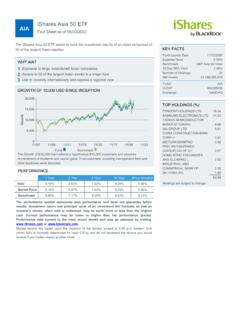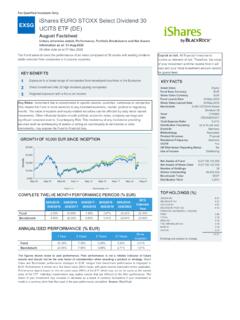Transcription of Guide to buying and selling ETFs - BlackRock
1 KNOW BETTER Guide to buying and selling ETFsETFs are funds that trade like a stock. They are a diversified, low-cost and tax-efficient way to invest. However, just like any investment, it is important to be familiar with when and how orders can be placed to seek the best practices when trading ETFs TIME: Markets can be more volatile near open and close. Consider trading after the first, and before the last, 20 minutes of the trading day. There is also less liquidity during opening and closing as market makers are less active during those times. When trading bond ETFs, note that the net asset value (NAV) of the fund is calculated once per day, normally at 4:00 ET, and is generally based on bid side (for some indices, mid) index prices snapped at the 3:00 ET bond market close.
2 However, the ETF price effectively represents the real time price of the bond portfolio as determined by exchange trading. Accordingly, seeing discounts to NAV in fast moving markets during this last hour before the exchange closes on which the ETF trades is entirely possible in volatile markets because of the reasons above; the ETF is showing a real-time, immediate execution at the portfolio level on exchange. ORDER TYPE: Just like trading individual stocks, make sure your order type is consistent with your goals. To help mitigate the impact of price swings, consider using limit or stop-limit orders (especially in volatile markets). If, however, it is important to make sure the trade executes, market or stop orders may be more appropriate (note the potential price risk, though!)
3 Key takeawaysTIME OF DAY MAT TERSC onsider avoiding trades near the market open or close, if PRICE PROTECTIOND uring times of volatility, consider limit or stop-limit orders, which give you more control over price than market or stop consider the Funds investment objectives, risk factors, and charges and expenses before investing. This and other information can be found in the Funds prospectuses or, if available, the summary prospectuses which may be obtained by visiting or Read the prospectus carefully before involves risk, including possible loss of can be no assurance that an active trading market for shares of an ETF will develop or be maintained.
4 Shares of iShares ETFs may be bought and sold throughout the day on the exchange through any brokerage account. Shares are not individually redeemable from the ETF, however, shares may be redeemed directly from an ETF by Authorized Participants, in very large creation/redemption units. Transactions in shares of ETFs will result in brokerage commissions and will generate tax consequences. All regulated investment companies are obliged to distribute portfolio gains to shareholders. Diversification and asset allocation may not protect against market risk or loss of strategies discussed are strictly for illustrative and educational purposes and are not a recommendation, offer or solicitation to buy or sell any securities or to adopt any investment strategy.
5 There is no guarantee that any strategies discussed will be effective. The information presented does not take into consideration commissions, tax implications, or other transactions costs, which may significantly affect the economic consequences of a given strategy or investment document contains general information only and does not take into account an individual s financial circumstances. This information should not be relied upon as a primary basis for an investment decision. Rather, an assessment should be made as to whether the information is appropriate in individual circumstances and consideration should be given to talking to a financial advisor before making an investment decision.
6 2020 BlackRock , Inc. All Rights Reserved. iSHARES and BlackRock are registered trademarks of BlackRock . All other marks are the property of their respective iShares Funds are distributed by BlackRock Investments, LLC (together with its affiliates, BlackRock ).Not FDIC Insured May Lose Value No Bank GuaranteeLit No. IS-INTROGDE-0420 GELM-333707-APR20-USWANT TO KNOW MORE?Visit typeKey featurePotential drawbacksPrice protection is importantBuy / sell only at price you determineLimit order: order executes only at the price specified, or betterControl over worst price at which trade executes ( , sell as long as price is no lower than $10)Order may not execute at all (if the ETF does not reach the specified price) or may be filled only partiallyHelp protect gains / reduce losses with price limitsStop-limit order.
7 Wait until price breaks through a specified level, then execute as limit orderBuy or sell a security following a specified price move, with full control over worst price at which the trade can execute ( , sell if price dips by more than 5%, but not beyond 10%)Execution is more important than price protectionBuy / sell immediatelyMarket order: order executes as soon as possible at the best price available at the timeImmediate execution of the trade in normal market conditionsIn times of market stress, realized price may be different from last quoted price. Also, execution may be delayed ( , if trading is halted)Help protect gains / reduce lossesStop order*: wait until price breaks through a specified level, then execute as market orderBuy or sell a security following a specified minimum price move ( , sell if price dips by more than 5%)* May also be referred to as a stop-loss or stop-market orderDetailed comparison of order typesICRMH0420U-1165537-2/2



















